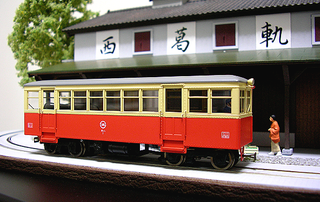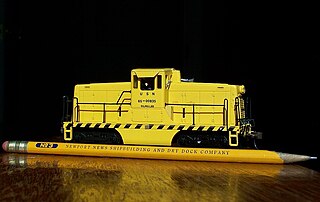
Railway modelling or model railroading is a hobby in which rail transport systems are modelled at a reduced scale.

A scale model is a physical model which is geometrically similar to an object. Scale models are generally smaller than large prototypes such as vehicles, buildings, or people; but may be larger than small prototypes such as anatomical structures or subatomic particles. Models built to the same scale as the prototype are called mockups.

Lionel, LLC is an American designer and importer of toy trains and model railroads that is headquartered in Concord, North Carolina. Its roots lie in the 1969 purchase of the Lionel product line from the Lionel Corporation by cereal conglomerate General Mills and subsequent purchase in 1986 by businessman Richard P. Kughn forming Lionel Trains, Inc. in 1986. The Martin Davis Investment Group (Wellspring) bought Lionel Trains, Inc. in 1995 and renamed it Lionel, LLC.

O scale is a scale commonly used for toy trains and rail transport modelling. Introduced by German toy manufacturer Märklin around 1900, by the 1930s three-rail alternating current O gauge was the most common model railroad scale in the United States and remained so until the early 1960s. In Europe, its popularity declined before World War II due to the introduction of smaller scales.

HO or H0 is a rail transport modelling scale using a 1:87 scale. It is the most popular scale of model railway in the world. The rails are spaced 16.5 millimetres (0.650 in) apart for modelling 1,435 mm standard gauge tracks and trains in HO.

American Flyer is a brand of toy train and model railroad manufactured in the United States.

N scale is a popular model railway scale. Depending upon the manufacturer, the scale ranges from 1:148 to 1:160. Effectively the scale is 1:159, 9 mm to 1,435 mm, which is the width of standard gauge railway. However the scale may vary to simulate wide or narrow gauge rail. In all cases, the gauge is 9 mm or 0.354 in. The term N gauge refers to the track dimensions, but in the United Kingdom in particular British N gauge refers to a 1:148 scale with 1:160 track gauge modelling. The terms N scale and N gauge are often inaccurately used interchangeably, as scale is defined as ratio or proportion of the model, and gauge only as a distance between rails. The scale 1:148 defines the rail-to-rail gauge equal to 9 mm exactly, so when calculating the rail or track use 1:160 and for engines and car wheel base use 1:148.
Standard Gauge, also known as wide gauge, was an early model railway and toy train rail gauge, introduced in the United States in 1906 by Lionel Corporation. As it was a toy standard, rather than a scale modeling standard, the actual scale of Standard Gauge locomotives and rolling stock varied. It ran on three-rail track whose running rails were 2+1⁄8 in apart.
The Ives Manufacturing Company, an American toy manufacturer from 1868 to 1932, was the largest manufacturer of toy trains in the United States from 1910 until 1924, when Lionel Corporation overtook it in sales.

A toy train is a toy that represents a train. It is distinguished from a model train by an emphasis on low cost and durability, rather than scale modeling. A toy train can be as simple as a toy that can run on a track, or it might be operated by electricity, clockwork or live steam. It is typically constructed from wood, plastic or metal. Many of today's steam trains might be considered as real ones as well, providing they are not strictly scale or not enough detailed ones in favor of a robustness appropriate for children or an inexpensive production.
K-Line Electric Trains is a brand name of O gauge and S gauge model railway locomotives, rolling stock, and buildings. Formerly the brand name under which Chapel Hill, North Carolina-based MDK Inc. sold its products, K-Line was then acquired by Sanda Kan, a Chinese toy manufacturer that formerly acted as K-Line's subcontractor. Sanda Kan had licensed the use of the K-Line brand and intellectual property to Lionel. More recently, the Lionel license expired, and Sanda Kan sold the dies to several other companies, with some going to each of Atlas, Bachmann, and RMT.
S scale is a model railroad scale modeled at 1:64 scale, S scale track gauge is 22.48 mm (0.885 in). S gauge trains are manufactured in both DC and AC powered varieties. S gauge is not to be confused with toy train standard gauge, a large-scale standard for toy trains in the early part of the 20th century.

The use of a third rail in rail transport modelling is a technique that was once applied, in order to facilitate easier wiring.

A slot car or slotcar is a powered miniature automobile or other vehicle that is guided by a groove or slot in the track on which it runs. A pin or blade extends from the bottom of the car into the slot. Though some slot cars are used to model highway traffic on scenic layouts, the great majority are used in the competitive hobby of slot car racing or slot racing.

Lionel Corporation was an American toy manufacturer and holding company of retailers that was founded in 1900 and operated for more than 120 years. It started as an electrical novelties company. Lionel specialized in various products throughout its existence. Toy trains and model railroads were its main claim to fame. Lionel trains have been produced since 1900, and their trains were admired by model railroaders around the world for the solidity of their construction and the authenticity of their detail. During its peak years in the 1950s, the company sold $25 million worth of trains per year.
A model commercial vehicle is a scale model or die-cast toy that represents a commercial vehicle: truck (lorry), bus, etc.

Playart was a toy company owned by Hong Kong industrialist Duncan Tong (唐鼎康) that specialized in die-cast cars, similar in size and style to Hot Wheels, Matchbox or Tomica. Cars were well done, but were often diecast seconds from other companies like Yatming or Tomica. Cars were made from 1965 to 1983 at the factory in San Po Kong, Kowloon, Hong Kong. Plastic cars and trucks of 1:43, and 1:24 scale were also made, while trains and other theme toys also appeared.

1:64 scale is a traditional scale for models and miniatures, in which one unit on the model represents 64 units on the actual object. It is also known as "three-sixteenths scale", since 3/16 of an inch represents one foot. A human is approximately 1+1⁄16 inches (27 mm) tall in 1:64 scale. The scale originated by halving the very common 1:32 scale, which was known as "standard size" in some hobbies.

The San Diego Model Railroad Museum is a model railroad exhibit in San Diego, California. At 27,000 sq. ft., it is the largest such indoor exhibit in North America, and one of the largest in the world. The museum is located on the lower level of the Casa de Balboa Building on the Prado in Balboa Park.














